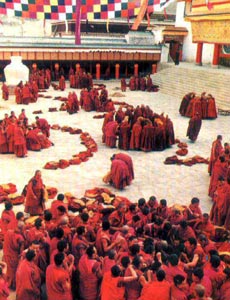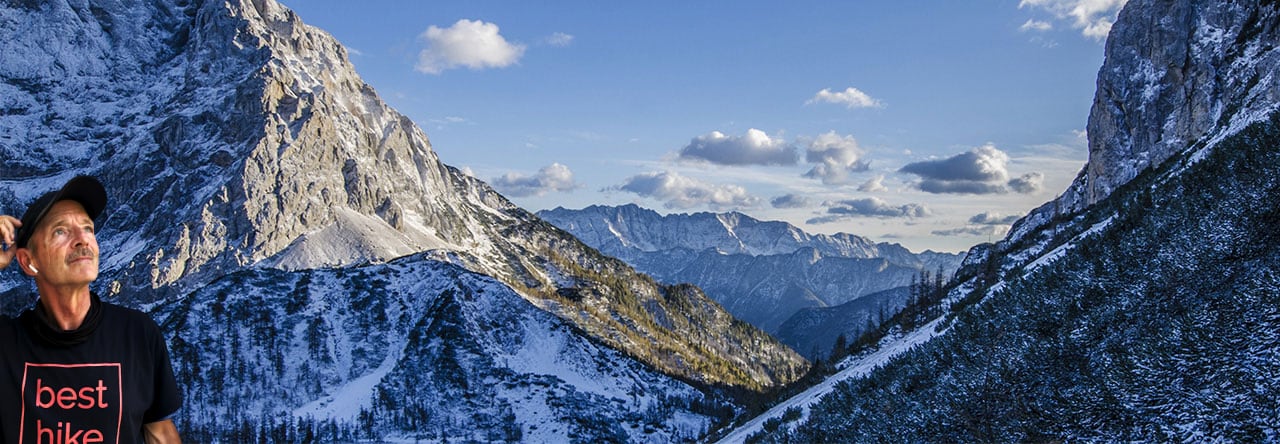my favourite place in China
Sweeping grasslands. Yaks and sheep in the tens of thousands. The most amazing thing I’ve seen in China! It made me long to have been there with the Buffalo in North America.
Wild-eyed, spiky-haired Mongol nomad cowboys ride into town, filthy, big knifes dangling. They are unabashed gawkers, some having rarely seen a Westerner before … except on TV.
Backpackers love to go where there are no suitcase tourists, to locales not yet ruined by too many visitors. A sad, true paradox.
Especially in China, the famous tourists stops here you would find crowded, littered, expensive, and tacky.
So I went to Langmusi, the most Tibetan place outside of Tibet. This is a simple and remote little town visited only by Buddhist pilgrims and a few backpackers. The locals are excited that next year, when the hospital opens, the town will have running water.
Life is simple. We live on wood stove baked apple pie with Yak yogurt. We drink eight-flavour tea (different fruits and berries) sweetened with slow disolving rock sugar.
At this, our favourite tiny Muslim restaurant, little daughter does her math homework (diligently, but incorrectly), son slurps his second bowl of noodles, and big-nose tourist reads Dostoyevsky.
Later the kids help me with my Mandarin. About 70% of Chinese speak Mandarin, and about 95% of backpackers. After a month in China I am the worst except for Julio from Spain, who doesn’t know a word. We often sit dumb and dumb.
The other major dialect is Cantonese, spoken in the South. The two can’t understand each other but they share the same written language. You need to know between 2000 – 3000 characters to read a newspaper. In 1954, in the interest of universal literacy, about 2000 characters were simplified. However, more and more Chinese want a return to the elegant full-form pictograms.
In 1958 the central government adopted Pinyin, a system of writing using our Roman alphabet. This was (somewhat) helpful for foreign devils but to most Chinese Pinyin looks like gobbledegook. They can’t read it.
Why do I mention all this? The bottom line is that the traveller in China must be able to speak conversational Mandarin or they are doomed.
I am doomed.
 The thing to do here is to praise the colourful ethnic minorities and criticize the Han oppressors. But that hasn’t been my experience. The Chinese I have met are kind and tolerant of minorities, even weird backpackers. It is a pleasure to travel in a land with so few rowdy young males. The men are almost gentle.
The thing to do here is to praise the colourful ethnic minorities and criticize the Han oppressors. But that hasn’t been my experience. The Chinese I have met are kind and tolerant of minorities, even weird backpackers. It is a pleasure to travel in a land with so few rowdy young males. The men are almost gentle.
The Muslim people in China are often strikingly handsome, photogenically pretty. They are hard-working and well educated, but keep a low profile. The call to prayer is not amplified. It’s been this way since the 1870s when the Chinese put down the last Muslim rebellion, killing millions and laying waste to entire cities.
The thing to do especially (to spite the ruthless Chinese police state, despite Brad Pitt) is to promote Tibet, Tibetans, and Tibetan Buddhism. The Tantric Buddhism here, as you know, is bizarre and mystical, heavily influenced by the pre-Buddhist Bon religion. It is characterized by mantras (sacred chanting), yantras (sacred art), and secret initiation rites. It is terrifically compelling.
 The thing to do here is to praise the colourful ethnic minorities and criticize the Han oppressors. But that hasn’t been my experience. The Chinese I have met are kind and tolerant of minorities, even weird backpackers. It is a pleasure to travel in a land with so few rowdy young males. The men are almost gentle.
The thing to do here is to praise the colourful ethnic minorities and criticize the Han oppressors. But that hasn’t been my experience. The Chinese I have met are kind and tolerant of minorities, even weird backpackers. It is a pleasure to travel in a land with so few rowdy young males. The men are almost gentle.And the colours, the colours! Red robed monks. Washed, stained yellows, brick reds, browns, and bright blues. What spectacle!
Westerners decry the Chinese liberators of Tibet. We hate that the spiritual leader and 100,000 Tibetans were driven to exile. We mourn the 1.2 million Tibetan deaths and destruction of much of the Tibetan cultural heritage.
Wrong rumours still flourish that Tibetan women are made sterile in Chinese hospitals after their first child.
And backpackers particularly hate the extortionary cost of travel into Tibet. Like me, they are constantly seeking ways to enter Tibet illegally, to get one up on the Chinese authorities.
First I travelled to Little Tibet, Xiahe, in Gansu Province. It can be otherworldly. Outside of Lhasa, this is the leading monastery town. Once part of Tibet, at its peak it housed 4000 monks studying the hard sciences like Astrology and Esoteric Buddhism.
Several times the monk population has been decimated. But in 1999, I count 2000 monks here — and the number is increasing.
Amazingingly, there are pictures of the Dalai Lama here! The authorities don’t like it but, so far, the photos haven’t been removed. Soldiers are visible in town, even in the monasteries.
But Beijing , in reality, doesn’t have much influence this far West.
The Tibetans are striking. Especially when the Dalai Lama himself sits down beside you in the bus. (Well, it looked like him.) Tibetans often greet you by sticking out their tongue. Demons cannot disguise their forked tongues, you see.
I had always assumed that Tibetan cheeks were ruddy from wind and sun — but it appears to be genetic! I’d always assumed that the smudged faces and grimy clothing were due to a lack of water in Tibet — but it appears to be cultural. There is plenty of water in Xiahe, but most of the Tibetans are dirty.
The population here is 10% Muslim, 45% Chinese, 45% Tibetan. Many of the Tibetans have lice but none, I’m certain, of the Chinese or Muslims do. (I can’t vouch for all of the backpackers.) Many Tibetans live and sleep in their huge heavy robes and coats. They just don’t wash much. And the toilets are the filthiest I’ve suffered.
 It is hilarious to watch Buddhist monks playing ping-pong, shooting baskets, or watching TV. For young students this is an exalted boarding school.
It is hilarious to watch Buddhist monks playing ping-pong, shooting baskets, or watching TV. For young students this is an exalted boarding school.
It is harvest here too. A beautiful time of the year. Most of the grains have been cut. Everything is done by hand. Cabbage, corn, and sunflowers are still up.
Yesterday, about 7 vehicles ahead of my bus, a potato truck overturned, falling over a cliff. The driver must have fallen asleep, I was told. Only about 5 sacks of potatoes roadside survived.
Motor vehicle accidents are by far the greatest risk in these countries.
I’m en route to Golmud to check-out the worst bus ride on Earth to Lhasa. (That claim is hotly disputed.) It’s 38 – 75 hours with 2 scheduled stops and a series of unscheduled flat tires, breakdowns, landslides, avalanches.
If I don’t like what I see in Golmud, I’ll consider my options.
PS
The Songpan fire resulted in 130 displaced families. I saw at least 2 people badly burned, & 1 soldier down from smoke inhalation. Locals told us that no one was killed. Others said that 1 child had died.
PPS
The numbing, spicy detergent taste in Sichuan food is “huajiao”, literally flower pepper. You can’t avoid it. Later I found I started to acquire a taste for it (in very small quantities).
Many locals offered us a chance to try the Sichuan Hot Pot, dipping skewers into hot spicy oil. Apparently I dodged a bullet. It is said that no non-Sichuanese can tolerate that dish.
PPPS
It turns out that Maotai (white alcohol) is a brand given out only as a special gift, costing between 300 – 500 Yuan. The locals drink a version costing 38 Yuan. Only backpackers buy the 6 Yuan rotgut.
 It is hilarious to watch Buddhist monks playing ping-pong, shooting baskets, or watching TV. For young students this is an exalted boarding school.
It is hilarious to watch Buddhist monks playing ping-pong, shooting baskets, or watching TV. For young students this is an exalted boarding school.
